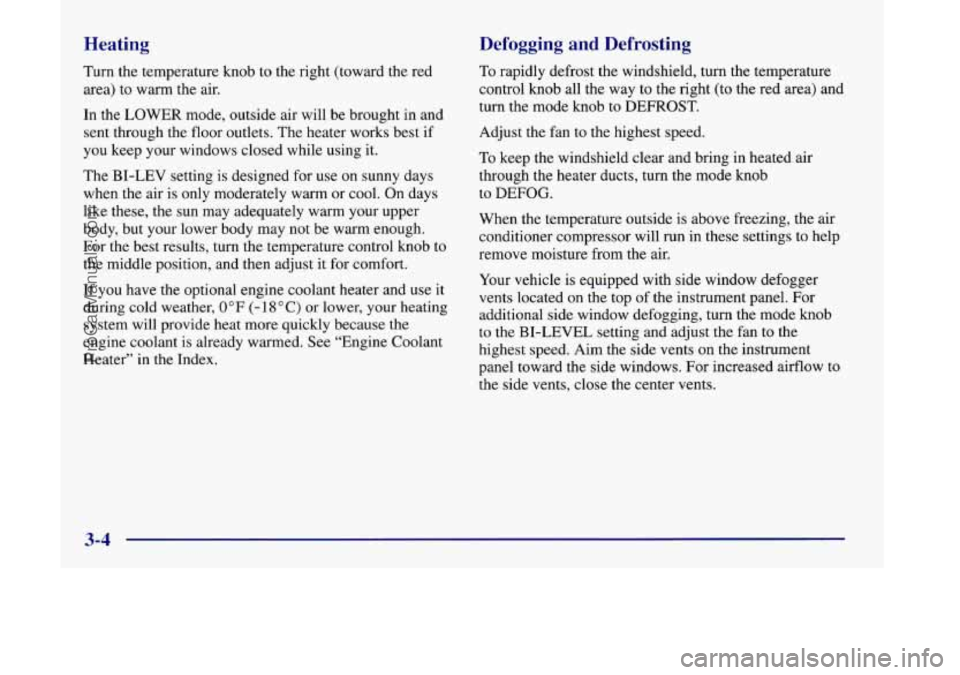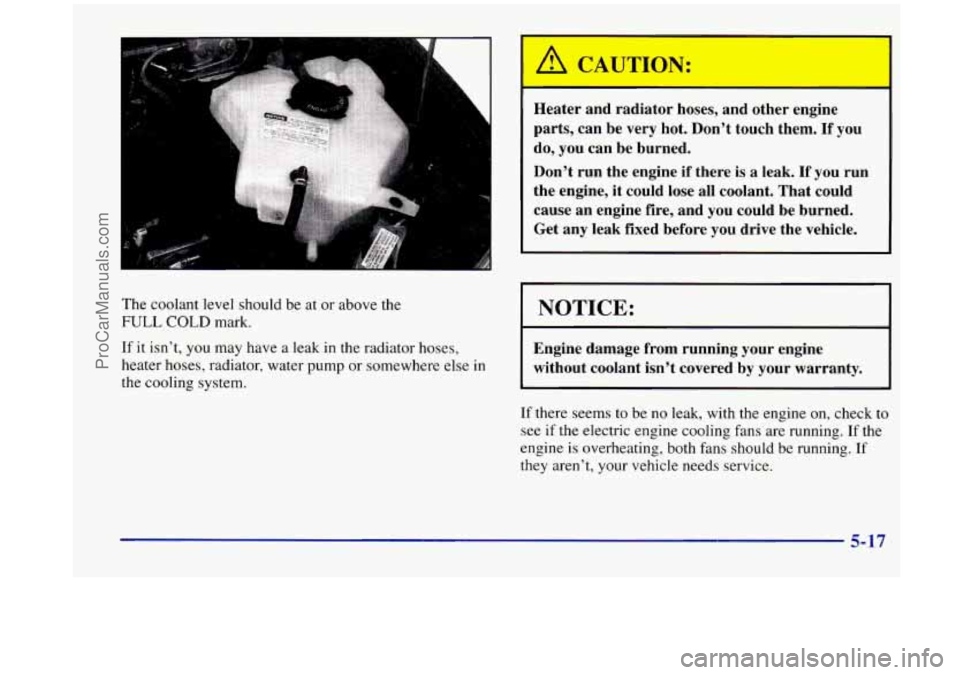coolant level OLDSMOBILE SILHOUETTE 1998 Owners Manual
[x] Cancel search | Manufacturer: OLDSMOBILE, Model Year: 1998, Model line: SILHOUETTE, Model: OLDSMOBILE SILHOUETTE 1998Pages: 444, PDF Size: 23.2 MB
Page 195 of 444

Low Coolant Light
If this light comes
on, your system is low
on coolant and the
engine may overheat.
To prevent damage to your engine, immediate
action
is required.
See “Engine Coolant” in the Index and have your
vehicle serviced
as soon as possible.
Malfunction Indicator Lamp (Service Engine Soon Light)
SERVICE
ENGINE
SOON
United States
CHECK
Canadian
Your vehicle is equipped with a computer which
monitors operation
of the fuel, ignition and emission
control systems.
This system
is called OBD I1 (On-Board
Diagnostics-Second Generation) and is intended to
assure that emissions are at acceptable levels for the life
of the vehicle, helping to produce a cleaner
environment. The SERVICE ENGINE SOON light
comes on and
a chime will sound to indicate that there is
a problem and service is required. Malfunctions often
will be indicated by the system before any problem is
apparent. This may prevent more serious damage to
your vehicle. This system is
also designed to assist
your service technician
in correctly diagnosing
any malfunction.
2-93
ProCarManuals.com
Page 208 of 444

Heating
Turn the temperature knob to the right (toward the red
area) to warm the air.
In the LOWER mode, outside air will be brought in and
sent through the floor outlets.
The heater works best if
you keep your windows closed while using it.
Defogging and Defrosting
To rapidly defrost the windshield, turn the temperature
control knob all the way to the right (to the red area) and
turn the mode
knob to DEFROST.
The BI-LEV setting
is designed for use on sunny days
when the air is only moderately warm or cool. On days
like these, the sun may adequately warm your upper
body, but your lower body may not be
warm enough.
For the best results, turn the temperature control knob
to
the middle position, and then adjust it for comfort.
If
you have the optional engine coolant heater and use it
during cold weather, 0 “F (- 18 O C) or lower, your heating
system will provide heat more quickly because the
engine coolant is already warmed. See “Engine Coolant
Heater” in
the Index. Adjust the
fan to the highest speed.
To keep the windshield clear and bring in heated air
through the heater ducts, turn the mode knob
to DEFOG.
When the temperature outside
is above freezing, the air
conditioner compressor will run in these settings to help
remove moisture from the air.
Your vehicle is equipped with side window defogger
vents located
on the top of the instrument panel. For
additional side window defogging, turn the mode knob
to the BI-LEVEL setting and adjust the fan to the
highest speed. Aim the
side vents on the instrument
panel toward the side windows. For increased airflow to
the side vents, close the center vents.
3-4
ProCarManuals.com
Page 287 of 444

Engine Overheating
You will find a coolant temperature gage on your
vehicle’s instrument panel. See “Engine Coolant
Temperature Gage” in the Index. You also have a low
coolant level light on your instrument panel. See “LOW
Coolant Light” in the Index.
Overheated Engine Protection
Operating Mode
Should an overheated engine condition exist, an
overheat protection mode which alternates firing groups
of three cylinders helps prevent engine damage. In this
mode, you will notice a significant loss in power and
engine performance. The
low coolant light may come on
and the temperature gage will indicate an overheat
condition exists. This emergency operating mode allows
your vehicle to be driven to a safe place in an
emergency. Towing a trailer in the overheat protection
mode should be avoided.
1 NOTICE:
After driving in the overheated engine protection
operating mode, to avoid engine damage, allow
the engine to cool before attempting any repair.
The engine oil will be severely degraded. Repair
the cause of coolant loss and change the oil. See
“Engine Oil, When to Change” in the Index.
ProCarManuals.com
Page 291 of 444

The coolant level should be at or above the
FULL COLD mark.
If it isn’t,
you may have a leak in the radiator hoses,
heater hoses, radiator, water pump or somewhere else in
the cooling system.
’ A CAUTION:
Heater and radiator hoses, and other engine
parts, can be
very hot. Don’t touch them. If you
do, you can be burned.
Don’t run the engine if there is a leak.
If you run
the engine,
it could lose all coolant. That could
cause an engine fire, and you could be burned.
Get any leak fixed before you drive the vehicle.
~
NOTICE:
Engine damage from running your engine
without coolant isn’t covered by your warranty.
If there seems to be no leak, with the engine on, check to
see if the electric engine cooling fans are running.
If the
engine
is overheating, both fans should be running. If
they aren’t, your vehicle needs service.
5-17
ProCarManuals.com
Page 292 of 444

IN:
How to Add Coolant to the Coolant
Recovery
Tank
If you haven’t found a problem yet, but the coolant
level isn’t at or above the FULL COLD mark, add a
50/50 mixture of clean water (preferably distilled) and
DEX-COOL@ engine coolant at the coolant recovery
tank.
(See “Engine Coolant” in the Index for
more information.)
- -
Adding only plain water to your cooling system
can be dangerous. Plain water, or some other
liquid like alcohol, can boil before the proper
coolant mixture will. Your vehicle’s coolant
warning system is set for the proper coolant
mixture. With plain water or the wrong mixture,
your engine could get too hot but you wouldn’t
get the overheat warning. Your engine could
catch fire and you or others could be burned.
Use
a 50/50 mixture of clean water and
DEX-COOL@ coolant.
NOTICE:
In cold weather, water can freeze and crack the
engine, radiator, heater core and other parts.
Use the recommended coolant and the proper
coolant mixture.
5-18
ProCarManuals.com
Page 296 of 444

3. Fill the radiator with the proper DEX-COOL@
coolant mixture, up to the base of the filler neck.
(See “Engine Coolant” in the Index for more
information about the proper coolant mixture.)
4. Start the engine and let it run until you can feel the
upper radiator hose getting hot. Watch out for the
engine cooling fans.
5. By this time, the coolant level inside the radiator
filler neck may be lower. If the level is lower, add
more of the proper
DEX-COOL@ coolant mixture
through the filler neck
until the level reaches the
base of the filler neck.
5-22
ProCarManuals.com
Page 311 of 444

Section 6 Service and Appearance Care
Here you will find information about the care of your vehicle. This section begins with service and fuel information,
and then it shows how to check important fluid and lubricant levels. There
is also technical information about your
vehicle, and a part devoted to its appearance care.
6-2 6-3
6-7
6-8
6-1
1
6-15
6- 16
6-18
6-2 1
6-24
6-26
6-27
6-30
6-3 1
6-38 Service
Fuel
Filling a Portable Fuel Container
Checking Things Under the Hood
Engine Oil
Air Cleaner
Passenger Compartment Air Filter
Replacement
Automatic Transaxle Fluid
Engine Coolant Radiator Pressure Cap
Windshield Washer Fluid
Brakes
Battery
Bulb Replacement
Windshield Wiper Blade Replacement 6-39
6-47
6-47
6-50
6-53
6-53
6-54
6-55
6-56
6-64
6-64
6-64
6-65
6-65
6-65 Tires
Appearance Care
Cleaning the Inside
of Your Vehicle
Cleaning the Outside of Your Vehicle
Underbody Maintenance
Chemical Paint Spotting
Appearance Care Materials Chart
Vehicle Identification Number (VIN)
Electrical System
Replacement Bulbs Capacities and Specifications
Engine Specifications
Vehicle Dimensions
Normal Maintenance Replacement Parts
Air Conditioning Refrigerants
6-1
ProCarManuals.com
Page 333 of 444

Checking Coolant
The engine coolant reservoir is located on the driver’s
side
of the vehicle, above the air cleaner.
When your engine
is cold, the coolant level should be
at
FULL COLD, or a little higher. When your engine
is warm, the level should be above the
FULL COLD
mark, or a little higher.
Adding Coolant
If this light comes on, it
means you’re low on
engine coolant.
If you need more coolant, add the proper DEX-COOL@
coolant mixture at the coolant recovery tank.
-
Turning the radiator pressure cap when the
engine and radiator are hot can allow steam and
scalding liquids to blow out and burn you badly.
With the coolant recovery tank, you will almost
never have
to add coolant at the radiator. Never
turn the radiator pressure cap
-- even a little --
when the engine and radiator are hot.
6-23
ProCarManuals.com
Page 405 of 444

Part B: Owner Checks and Services
Listed below are owner checks and services which
should be performed at the intervals specified to help
ensure the safety, dependability and emission control
performance
of your vehicle.
Be sure any necessary repairs are completed at once.
Whenever any fluids or lubricants are added
to your
vehicle, make sure they are the proper ones, as shown in
Part
D.
At Each Fuel Fill
It is important for you or a service station attendant to
pe~orm these underhood checks
at each fueljill.
Engine Oil Level Check
Check the engine oil level and add the proper oil if
necessary. See “Engine Oil” in
the Index for
further details.
Engine Coolant Level Check
Check the engine coolant level and add DEX-COOL@
coolant mixture if necessary. See “Engine Coolant”
in
the Index for further details.
Windshield Washer Fluid Level Check
Check the windshield washer fluid level in the
windshield washer tank and add the proper fluid if
necessary. See “Windshield Washer Fluid” in the Index
for further details.
At Least Once a Month
Tire Inflation Check
Make sure tires are inflated to the correct pressures. See
“Tires” in the Index for further details.
Cassette Deck Service
Clean cassette deck. Cleaning should be done every
50 hours of tape play. See “Audio Systems” in the Index
for further details.
7-29
ProCarManuals.com
Page 430 of 444

Driving (Continued)
On Curves
.................................. 4- 11
On Grades While Towing a Trailer ............... 4-39
On Hill and Mountain Roads
.................... 4-24
On Snow and Ice
............................. 4-26
Throughwater
............................... 4-20
WetRoads
.................................. 4-18
Winter
...................................... 4-26
With a Trailer
................................ 4-37
Dump and
Stow Feature ........................... 1-7
Electrical Equipment. Adding .................... 2-28
Electrical System
............................... 6-56
Electronic Level Control
......................... 4-32
Engine
....................................... 6-10
Coolant ..................................... 6-21
Coolant Heater
............................... 2-29
Coolant Level Check
.......................... 7-29
Coolant Temperature Gage
..................... 2-92
Cooling System
.............................. 6-64
Exhaust
..................................... 2-38
Identification
................................ 6-55
OilLevelCheck
.............................. 7-29
Overheated Protection Operating Mode
........... 5- 13
Overheating
................................. 5-13
Specifications
................................ 6-64
StartingYour
................................ 2-27
Temperature Warning Light
..................... 2-92
Additives
................................... 6-14
Checking
................................... 6-12
Running
While Parked
......................... 2-39
Engine Oil
............................... 2-96. 6-11 Used
....................................... 6-15
What Kind to Use
............................. 6-13
WhentoAdd
................................ 6-12
Equipment. Adding to the Outside
Of Your Vehicle ..... 6-3
When
to Change
.............................. 6-14
Exhaust. Engine ................................ 2-38
Exit Lighting
.................................. 2-62
Fabric Cleaning
............................... 6-48
Fan Knob. Climate Control System
.................. 3-2
Filling a Portable Fuel Container
.................... 6-7
Filling Your Tank
................................ 6-5
Filter. Air
..................................... 6-15
Filter. Passenger Compartment Air
................. 6-16
Finishcare
.................................... 6-51
Finish Damage
................................. 6-53
FirstGear
..................................... 2-33
Flashers. Hazard Warning
......................... 5-2
Flat Tire. Changing
............................. 5-24
Fluid Capacities
................................ 6-64
FogLmps
.................................... 2-60
Folding Driver’s Seatback
......................... 1-3
Foreign Countries. Fuel
........................... 6-5
FrenchLanguage Manual
11
FrontDoor ..................................... 2-4
Front Parking/Turn Signal Lamp Bulb Replacement
.... 6-34
Front Seat Storage Bin
........................... 2-71
Front Seat Storage Net
........................... 2-71
Front Sidemarker Lamp Bulb Replacement
........... 6-36
FrontTowing
.................................. 5-10
Fluids and Lubricants
............................ 7-34
.. ...........................
9-4
.
ProCarManuals.com